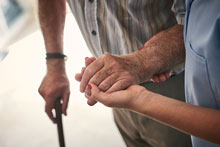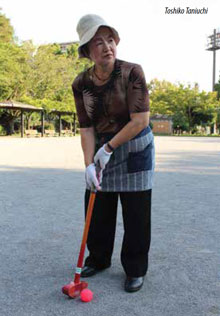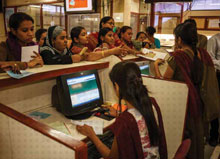A Helping Hand
In Japan and India, two women navigate life’s transitions

Social protection comes in various forms. In Japan, an advanced economy, retirees like Toshiko Taniuchi will make up two-fifths of the population by mid-century. Thanks to her government pension and help from her family, she remains active and independent. In youthful India, by contrast, most workers labor in the informal sector, without state-provided social protection. Jetunbibi Shirajbhi Seikh’s family was having trouble making ends meet until she joined an association of self-employed women, which helped her start a business. As these two women’s stories show, social protection not only shields individuals from the vagaries of life, but it helps them fulfill their potential, to the benefit of families, communities, and society.
Keeping active in Japan

Toshiko Taniuchi participated in Japan’s post–World War II economic miracle, as a growing population helped fuel a rapid expansion in output. She ran a shop in Tokyo while raising three children. Today, Taniuchi is retired, and the trend has reversed. An aging and shrinking population is weighing on economic growth.
Taniuchi, now 79 years old, has lived with her son and his family since her husband’s death several years ago. She worries about being a burden on her family, so she strives to stay fit and healthy.
"I exercise and keep active to try not to cause my children too much trouble," she says. She also visits a physical therapist to recover from a back operation. "Luckily there’s a bus that stops a 10-minute walk away from the rehabilitation center, and that short walk helps me stay fit."
Taniuchi keeps to a strict schedule, starting her day with exercises from a radio program at 6:30 a.m. She goes to karaoke three times a month, calligraphy on the first Saturday of every month, drawing on the third Tuesday, and ground golf—a type of croquet—once a week. Then there are community events, like local disaster drills and neighborhood cleanup drives.
"I try to do these things and exercise to avoid getting dementia," she says. "I make sure I’m doing different things instead of sitting watching TV, cleaning, and doing laundry."
Japan famously has the world’s oldest population, with people 65 and older accounting for about 27 percent of its 127 million people, according to government estimates, up from 9 percent in 1980. The proportion of elderly people is forecast to rise almost to 40 percent by 2050.
The demographic shift is putting pressure on Japan to improve productivity and expand the labor force, which could be done by bringing in more women and older workers. That would require eliminating disincentives to full-time and regular work and making childcare and eldercare more widely available to free people from domestic duties, according to the IMF’s July 2017 country report on Japan.
Taniuchi was born in Fukushima, a prefecture about a two-hour-plus drive
northeast of Tokyo known for excellent mountain hiking and centuries-
old onsen, or hot-spring baths. She moved to Tokyo in 1954,
married, and opened a grocery store. Today, she shares a three-story home
with her son, an office worker, and his wife and children. She rents out
the ground floor to a local business.
Taniuchi maintains an active social life, helping her friends avoid the loneliness and isolation of many elderly Japanese. About 15 percent of men over 65 and 5 percent of women say they go as long as two weeks without talking to anyone, according to a nationwide survey conducted in August. More than 30 percent of men and 9 percent of women in the same age group said they have no one to rely on in their day-to-day lives.
"If I’m alone at home I like to go visit my friends who are also at home alone," she says. Recently, she visited a female friend who is confined to a wheelchair and cannot leave the house. Her friend hadn’t spoken to anyone all day.
Finances are a concern for many older people in Japan, as they are for other age groups. Among those in the national survey who said living circumstances were somewhat difficult, difficult, or very difficult, 40-year-olds were the biggest group, at 38 percent. The 60-year-olds were next, at 37 percent.
Taniuchi’s expenses are high: there’s medical insurance, fire insurance, and mortgage payments on her house, which aren’t covered by the rental income from the ground floor.
Still, "I can get by in my current circumstances," she says. "I get help from my children."
A tailor’s tale

Jetunbibi Shirajbhi Seikh, a home-based informal worker from Ahmedabad in the western Indian state of Gujarat, got married when she was 18 years old. At the time, her husband was the sole breadwinner, earning less than Rs 1,850 ($25) a month doing odd jobs. With six family members relying on her husband’s income, daily life was demanding and difficult.
Then things got even worse. Seikh’s mother-in-law was diagnosed with tuberculosis, and because her family didn’t have health insurance, they mortgaged some of their few possessions, including wedding jewelry, to pay for her treatment. Without substantial assets, they could not get a loan from a formal bank, so Seikh was forced to borrow from local lenders at absurdly high interest rates—trapping her and her family in a vicious cycle of debt and poverty.
Seikh’s story is far from unique. More than 90 percent of India’s working population is in the informal sector. Among these people, more than 50 percent work in agriculture and allied trades, and more than 20 percent work in low-end manufacturing and services. Employment opportunities in the informal economy are always changing because of fierce competition, market trends, and changing economic policies. It is common, then, for informal workers to pursue more than one trade. A street vendor during the day may also work as a bidi (Indian cigar) roller at night and a kite maker during the kite festival. Informal workers rarely have any kind of insurance, health care, childcare, or access to formal banking. The lack of social protection is one of these workers’ major hurdles to escaping from debt and poverty and to living a decent, dignified life.
One day, Seikh’s neighbor introduced her to the Self-Employed Women’s Association (SEWA), a trade union of more than 1.5 million low-income, informal sector women workers. SEWA promotes work, income, and social security for its members by offering direct access to loans and by facilitating access to health insurance, life insurance, home insurance, and crop insurance for rural workers, among other services. Its membership includes workers from more than 125 trades, including tailors, waste pickers, street vendors, home-based workers, animal husbandry workers, and artisans.
Seikh signed up and immediately opened an account with SEWA Bank and began saving Rs 5 ($.07) a month. She then enrolled her children in SEWA’s childcare center and entered a tailoring program. After six months, Seikh took out a loan for Rs 10,000 ($135) and launched her own tailoring business from home. What began with small repairs and alterations grew to T-shirts, shorts, vests, and other apparel. Before long she was earning more than Rs 11,000 ($150) a month, and she was also producing her own ready-made garments.
Now 51 years old, Seikh has had her tailoring business for more than a decade. Her family earns more than Rs 55,000 ($750) a month. When she was an informal worker, she and her family were vulnerable to the ups and downs of daily hardship, unable to rely on a steady income or plan for their future. Today, she runs a thriving business, has health insurance, life insurance, and—most important—home insurance covering her place of work and source of income. In short, Seikh has beaten the cycle of poverty.
PHOTO: DEAN MITCHELL; PHOTO: ISTOCK / JAMIELAWTON; PHOTO: SEAN LANGAN; PHOTO: WILLIAM ALBERT ALLARD
Opinions expressed in articles and other materials are those of the authors; they do not necessarily reflect IMF policy.







